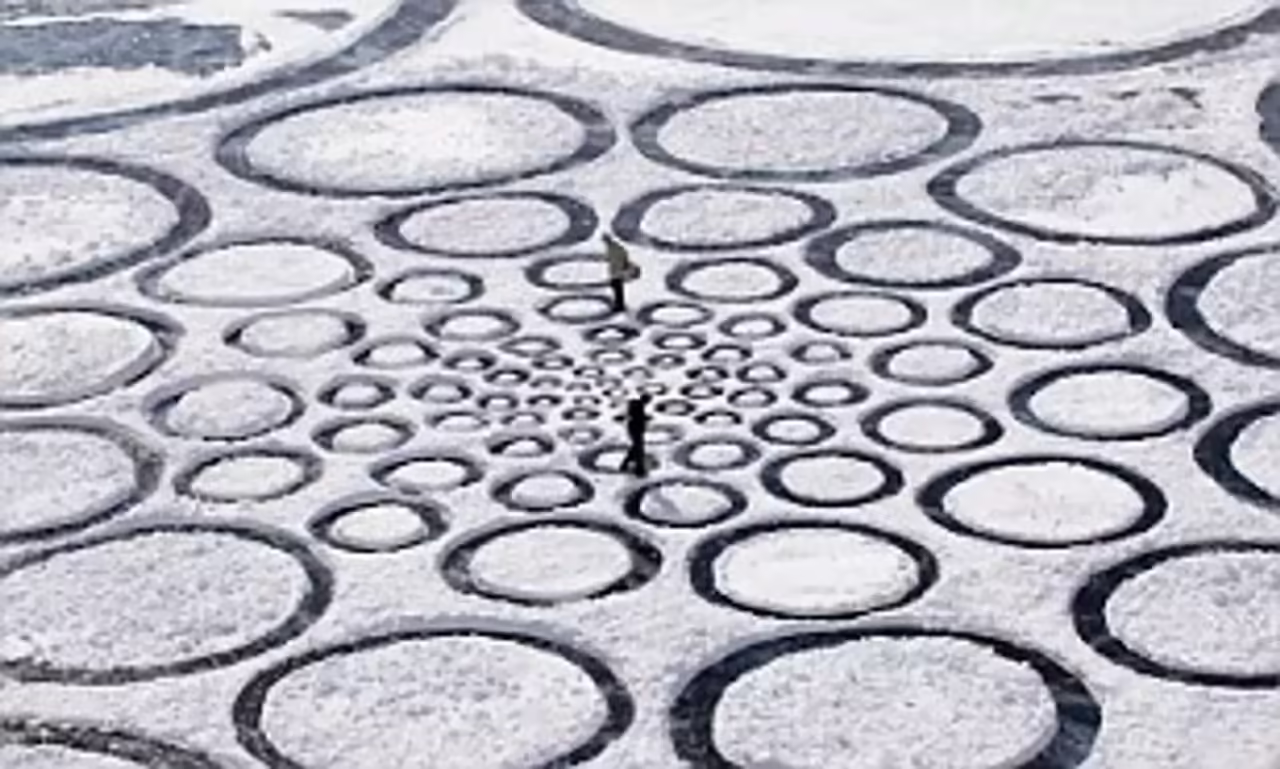
The great Lake Baikal
Being the largest and deepest body of freshwater in the world, storing within it no less than 20% of all the planet’s unfrozen freshwater, Lake Baikal is one of the great natural wonders of our planet and a truly magnificent site. We could talk here for hours about its peculiarities, from the only freshwater seal to a fish so oily that if taken out of the icy waters and put in the sun it will melt from the heat, to crystal clear waters that make it the least turbid lake on the planet.
But the subject that interests us today is something different. It is about the appearance in the ice of Lake Baikal of two perfectly circular figures of truly monumental size. To give you an idea of what we are talking about, the people who warned of the existence of the figures… were the astronauts of the International Space Station, because the circles are so large that a person from the ground would not be able to distinguish them.
The circles in the ice
In April 2009 the astronauts noticed two of these apparitions, one at the southern end of the lake and one at the northernmost part: both circles were about 4.5 kilometers in diameter. A closer shot showed that the circles were formed by a layer of ice that had become thinner as if something warm had landed on it.
Although many will automatically think of the appearance of a flying saucer, it seems that none of the inhabitants of the coasts witnessed any mysterious appearance in the skies of Baikal in this period, so such a hypothesis would be very difficult to justify. On the other hand, NASA claims to have the reason why these circles were created.
According to the researchers, they would be due to immense subway methane emissions that would rotate counterclockwise by the Coriolis effect (the same that gives direction to hurricanes), forming a kind of “submarine whirlwinds” that would create the holes as they ascend.
The explanation was never proven, since the holes disappeared soon after (with the arrival of summer) and have not reappeared to this day. Until they do, we cannot know with certainty whether it was really methane that caused the mysterious circles in Lake Baikal.
More adventurous hypotheses pointing to supernatural explanations have been proposed on several occasions, but seem unconvincing. However, an interesting version points to the influence of a submarine ship that was in the lake for unknown reasons (probably studies or secret missions of the Russian Navy) and then left the lake taking advantage of the thawing of the ice, which increases the flow of rivers.
Theories about the origin: exploring the different scientific and mythological explanations behind the phenomenon
Lake Baikal is the deepest and oldest lake in the world, and is home to a great diversity of life and culture. Its surface freezes over during the winter, creating a crystal-white landscape that is sometimes interrupted by strange circular ice formations. These circles have intrigued both scientists and local inhabitants, who have attributed different origins and meanings to them.
One of the most popular theories among researchers is that the icy circles are due to methane emissions coming from the bottom of the lake and creating eddies of warm water that melt the ice from below. This hypothesis is based on observations made by astronauts from the International Space Station, who captured two circles about 4.5 kilometers in diameter in April 2009. In addition, sensors have been installed in the lake that have detected differences in temperature and water movement beneath the circles.
Another theory suggests that the icy circles are the result of underwater volcanic activity, as Lake Baikal lies over an active seismic zone where earthquakes and eruptions occur. Some geologists believe that there are dormant volcanoes under the lake that could release heat and gases that would affect the surface ice.
However, not everyone accepts these scientific explanations, and some prefer to resort to local legends and myths to interpret the phenomenon. Lake Baikal is considered a sacred place by many indigenous cultures, such as the Buryat, Yakut and Evenki, who attribute magical and supernatural powers to it. Some believe that the icy circles are divine signs or portals to other worlds, where ancestral spirits or fantastic beings dwell. Others think they are footprints left by UFOs or unknown creatures visiting the lake.
Whatever the real origin of the icy circles of Lake Baikal, they are a fascinating and disturbing spectacle that awakens the curiosity and imagination of those who contemplate them.
The first sightings: how and when the first ice circles were discovered on Lake Baikal
Lake Baikal, located in Siberia, Russia, is the largest and deepest freshwater lake in the world, with a maximum depth of 1,642 meters. The lake is famous for its incredible biodiversity and crystal clear water, but it is also known for a mysterious phenomenon that has captured the attention of scientists and enthusiasts alike: icy circles.
Ice circles, also known as “ice disks,” are perfect circles of ice that appear on the surface of Lake Baikal during the winter. The circles range in diameter from a few meters to several kilometers and are surrounded by a thicker ice rim. The phenomenon is particularly interesting because it is not known for certain how these circles are formed.
The history of ice circles on Lake Baikal dates back more than a century. According to historical records, the first icy circles were seen by locals in the 1860s. At that time, Lake Baikal was a major fishing center, and local fishermen observed the circles while walking on the ice in search of a good place to fish.
In the early days, people didn’t know what to make of these strange ice circles. Many believed they were caused by the activity of mythical or supernatural creatures, such as Siberian water dragons. Others believed they were the result of natural processes, such as subway water currents or high winds.
It was not until the 1960s that scientists began to seriously study the phenomenon of ice circles on Lake Baikal. At that time, Soviet scientists conducted a series of studies on the lake and began documenting the appearance of the circles.
Since then, numerous scientific studies have been conducted on the icy circles in Lake Baikal. Scientists have studied the chemical composition of the lake water, underwater currents, the topography of the lake bottom, and many other factors that could be related to the formation of the circles.
However, despite decades of research, the mystery of the ice circles is still not completely solved. Although scientists have made progress in understanding how the circles form, there are still many aspects of the phenomenon that are not fully understood.
Life under the ice: discussing how biology may be involved in the formation of the circles.
Lake Baikal is a place of great biodiversity, with thousands of species of animals and plants calling this aquatic environment home. Many of these species have evolved to survive in extreme conditions of cold and darkness, and some of them may be playing a role in the formation of the icy circles.
One theory suggests that biology may be involved in the formation of the ice circles due to the presence of algae and bacteria in Lake Baikal. It is thought that these species may be producing gases that accumulate under the ice and form air pockets. As the ice moves and breaks up, these air pockets may coalesce and expand, creating the perfect icy circles we see on the surface of the lake.
In addition, it has been observed that some aquatic organisms can affect the texture of ice. For example, certain types of bacteria can produce a sticky substance that adheres ice particles together, resulting in thicker, denser ice. It has also been found that aquatic animals, such as sponges, can burrow small caves in the ice, which can weaken it and cause it to break up more easily.
Another factor that may be involved in the formation of ice circles is microscopic life in the water. Microorganisms can influence the chemical composition of the water, which can affect the way it freezes. For example, certain types of bacteria can produce acids that lower the freezing temperature of water, causing ice to form faster.
The mystery of the ice circles solved: discussing the possibilities of solving the mystery of the ice circles in the future
For decades, the icy circles in Lake Baikal have been an enigma to the scientific community and the general public. Despite research and study, the mystery of how these perfect ice circles are formed remains completely unsolved. Still, technology and innovation in science may offer solutions in the future.
One of the most widely accepted theories about the formation of ice circles is that they are influenced by underwater currents and the Earth’s rotation. When given the right conditions, ice circles form naturally on the surface of Lake Baikal. Although this theory is widely accepted, scientists are still investigating to better understand the processes involved.
Modern technology could be the key to unraveling this mystery. The use of drones and autonomous underwater vehicles would allow researchers to explore areas of Lake Baikal that are inaccessible to humans. These devices can also collect data and samples for analysis, which could help scientists identify the exact factors contributing to the formation of the icy circles.
In addition, innovation in computer modeling could also be a valuable tool in solving the mystery of the icy circles. Scientists can use models to simulate different scenarios and conditions in Lake Baikal, which could help identify the processes that lead to the formation of the ice circles. Data collected from the technology could also be used to refine these models and improve accuracy.
Another possibility for solving the mystery of the icy circles is through international collaboration between scientists and experts in different fields. Interdisciplinary research could be the key to fully understanding the formation of the icy circles, as the phenomenon is influenced by many different factors, including geology, meteorology, biology and physics.







